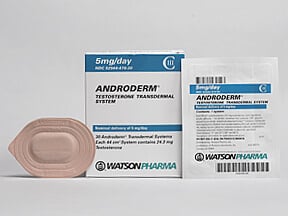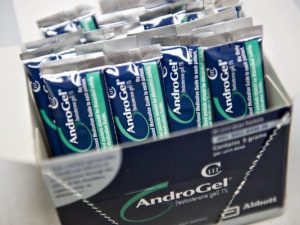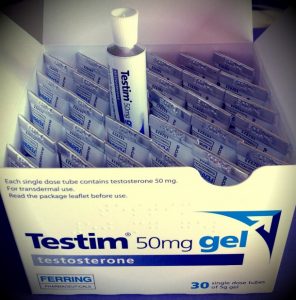History and Overview:
When talking about transdermal testosterone, it directly refers to the topical use of any testosterone medication or supplements applied directly onto the outer epidermis of the skin. In the past, the only available method of testosterone administration was via subcutaneous injections, and from when it hit the market in 1933 it was the only known method. Not long after the release of injectable testosterone appeared, oral tablets were made available.
Testosterone oral tablets were readily available and could be obtained with ease, however, they proved to be highly toxic to the liver. Therefore, the preferred route of administration was via subcutaneous injection and remained that way until the advent of topically applied transdermal testosterone was introduced.
The first topically applied skin based patches were developed in the eighties and didn’t take long before drastic improvements were made in the nineties. 1995 saw Androderm, manufactured by TheraTech gain the approval of the FDA and it is partly viewed as being responsible for the treatment of low testosterone. The new millennium saw the launch of Androgel, manufactured by Unimed Pharmaceutical and it was the very first cream containing testosterone that could be rubbed directly onto the body. Androgel led the way in creating the market for a topically applied testosterone and help bring the dream of testosterone replacement therapy into the lives of so many men in need of it.
Since the introduction of Androderm to the U.S, The European branding of ATMOS, and the worldwide branding of Androgel, there have been plenty of other transdermal products containing testosterone cashing in on the market. In fact, it is now common to be able to find an economical generic version. There are several ways of applying topical testosterone and one stands out from the rest for its unique design named Axiron. Axiron is applied via a roll-on system to the underarms and makes application as easy as applying deodorant. However, there have been no effective advantages of doing it this way than other transdermal testosterone, apart from perhaps the ease of application.
Transdermal Testosterone Properties and Actions:
Each and every variant of transdermal testosterone is comprised of the male hormone, testosterone, and this is true across the brands and generic versions. The testosterone that is found in transdermal testosterone creams and lotions is exactly the same as the testosterone found in the subcutaneous injection version. The only real difference between them is the way in which they are administered, which can, in certain men affect them differently in terms of the benefits gained from it. It may be easy to be sucked in by clever marketing and advertising of testosterone supplements, but the truth of the matter is that testosterone is simply just testosterone, and the body has no way of distinguishing between synthetic or naturally occurring hormone once it enters it.
Androderm/Atmos: this topical medication is an alcohol based testosterone gel and comes in a patch not dissimilar to those used by people looking to quit smoking. In the morning the patch will usually be applied and this is also when the most testosterone will be delivered to the body. The remainder of the day will see the remaining topical testosterone released gradually. It’s designed in a way that copies the natural release of testosterone in the body.

Androderm Testosterone Patch
Adroderm can be found in 2 different dosages, which are patches of 2.5mg and 5mg. The 2.5mg patch will deliver around 12mg of testosterone and the larger one providing 24.3mg. The number of patches applied during the day will vary depending on the requirements of the individual.
Androgel: Androgel is what is known as a hydroalcoholic and is a basic lotion which contains the active ingredient of testosterone hormone. In the same way, as to which patches are applied, transdermal creams are also placed on the skin in the morning. Androgel comes in strengths of 1% in 2.5mg & 5mg packets and the recent addition of the 1.62% is also available. It is possible to find powdered forms of testosterone ranging from 5% – 20%.

Androgel Testosterone Gel Sachets
The main function of all transdermal testosterone is to help deliver testosterone hormone to the body that is lacking it. When talking about lacking, we basically mean low testosterone condition. There is a myriad of reasons as to why a man may be suffering from low levels of testosterone, or levels below the recommended optimal level. As we get older, our naturally occurring testosterone levels begin to decline, and this is why age related low testosterone is most commonly cited as being the main cause. It is also possible for low testosterone to be the result of head or testicular injury. There are also lots of other causes of low testosterone which we have not mentioned above, so these will be touched upon below.
Common Causes Transdermal Testosterone Include:
- The age, genetics and health of the male.
- Any use of recreational drugs.
- Long-term use of opiate painkillers.
- The use of antidepressants. Cholesterol medications, such as Statins.
- Injury or trauma to the testes.
- Tumours of the pituitary gland.
- Use of anabolic steroids.
- Corticosteroid overexposure.
- Cancer and autoimmune conditions, HIV.
- Chemical and pollutant exposure.
- Alcoholism or regular heavy drinking.
It is difficult to miss the symptoms of low testosterone in men. However, it is possible to overlook the symptoms, especially ones such as lethargy and fatigue. The reason lethargy and fatigue are easy to miss is that they are a common daily part of life for many as they get older. There are some symptoms that will indicate the need for the use of TRT (testosterone replacement therapy) and these include the following:
- A complete or partial loss of libido or sexual interest.
- The inability to obtain or keep an erection – Erectile Dysfunction (ED).
- A reduction in muscle mass even when diet and exercise are optimal.
- A reduction in body strength, even when diet and exercise are optimal.
- An increase in the amount of body fat being deposited, especially on the hips and chest.
- Brain fog and the inability to concentrate.
- Loss of focus or an increasingly short attention span.
- Lethargic feelings, including tiredness, wanting to sleep more often and reduced mobility.
- The inability to be able to fall asleep or stay asleep –insomnia.
- Mood changes, including becoming easily irritated and emotional.
- Lack of energy, sleeping more than normal, lack of motivation.
- Depression and low moods which can last for days at a time.
- A weak immune system, leading to more illnesses than normal.
Symptoms may be an indication of low testosterone but the only way to truly know is by having a blood test done. Low testosterone may not be the main cause of the problem as other illnesses can lead to it. Don’t ignore low testosterone as long term low testosterone has been linked to the following conditions:
- Osteoporosis
- Anxiety
- Infertility
- Alzheimer’s
- Heart Disease
The Effects Of Transdermal Testosterone:
The positive effects are pretty straightforward. If you have low testosterone levels, then you simply apply a transdermal testosterone medication and your symptoms will lessen. While it is definitely great for alleviating symptoms, there are some things to take note of.
It will take several months to notice a dramatic improvement in symptoms. They will not simply vanish in the first few days of using it.
There may be times when your medication dose needs to be adjusted up or down. Too much testosterone can lead to the body not producing its own natural hormone, too little and your symptoms will still remain. It is all about balancing it over time.
You need to take it regularly and on time. Missing doses will reduce its effectiveness. Also, living a healthy lifestyle with good food and plenty of exercise helps.
Side Effects Of Transdermal Testosterone:
As with all hormones, the risk of side effects can be a very real thing. However, the majority of them will be infrequent and minimal at most. Below are the most commonly occurring side effects associated with Transdermal Testosterone use, broken into easy to understand categories. It is important to remember that testosterone is a naturally occurring hormone found in the bodies of all men and we have been producing it for most of our lives. Introducing a transdermal form of testosterone should not cause issues, however, there may at times be issues with the application and dosing.
Estrogenic Side Effects
The most common estrogenic side effect experienced with Transdermal Testosterone use is water retention. Testosterone does aromatize and convert to estrogen. Afterall, even men need a little bit of estrogen for proper bodily functioning. If you take too much Transdermal Testosterone there is a possibility of developing breast tissue, known as Gynecomastia. The use of an AI is optional and can help reduce the amount of aromatization that happens, however, AI’s can come with their own sets of problems. You don’t want to lower estrogen levels too low as that comes with issues too. Getting blood work done regularly will help you head in the right direction.
Androgenic Side Effects
Transdermal Testosterone can lead to androgenic side effects, such as hair loss, acne, and an increase in the amount of body hair. These are caused by a reduction in DHT from the influx of testosterone. Balding is a big issue for many men. If you don’t have MPB (*male pattern baldness) in your DNA then there is no way that Transdermal Testosterone can lead to hair loss or balding. Men who do have MPB may find that the increase in testosterone can lead to hair loss.
Cardiovascular Side Effects
Transdermal Testosterone use can lead to a strain of the heart. This should not occur if the user is using it at the prescribed dose and does not abuse it. The good cholesterol or HDL may be reduced and the bad cholesterol, LDL, may increase. There is also a risk that testosterone may thicken the blood by increasing the levels of hemoglobin and red blood cell numbers. This is not a common side effect and monitoring the situation with blood checks a few times a year will help.
Hepatoxicity Risks
The use of Transdermal Testosterone has shown to be nontoxic to the liver and presents no risks to the individual when using it.
Testosterone Suppression
Transdermal Testosterone will suppress the bodies ability to produce testosterone. The influx of Transdermal Testosterone will lead to the body thinking it is producing too much and therefore production slows and then stops. Of course, if you already have low testosterone levels then this will have no effect on you or your treatment plan.
Application Side Effects (Irritation)
As with any topical lotion or cream applied to the skin, there is a risk of redness, irritation, and inflammation. It may take time experimenting with different locations on the body to find one that works best. Transdermal Testosterone versions may need to be switched too, especially if you have an allergy to any of the ingredients in the emollient gels or creams.
Administration Of Transdermal Testosterone:
Depending on the type of Transdermal Testosterone that you opt to use will dictate the amount you apply and where it needs to be placed. The main thing to note is that regardless of the type, it must be applied topically to the skin and first thing in the morning. Before application, you should ensure that you have washed and are clean as this will help with absorption of Transdermal Testosterone.
Application Of Transdermal Testosterone Creams & Gels
Transdermal Testosterone creams & lotions of most often applied to the top of the shoulders or on the top of the arms or stomach. Typical doses will begin at 5mg each day and will be slowly increased up towards 10mg each day. It is important to avoid physical contact with females and children for the first 12 hours after application to avoid secondary contamination to them. If you need to have sex while using Transdermal Testosterone, you should shower first to remove it from the skin.

Testim Testosterone Gel
Application Of Transdermal Testosterone Patches
Think of these like sticky plasters. They are applied to the skin with an adhesive, most commonly to the arms, thighs, or stomach. They are applied first thing in the morning and skin should be clean and not wet. Dosage is around the 2.5mg – 5mg mark per day.
Transdermal Testosterone Availability:
Transdermal Testosterone is widely available in the U.S and in most other countries around the world. Named brands tend to be the most expensive and can cost much more than generic versions. The compounded creams are the most economical choice for those on a budget. Transdermal Testosterone is not usually found on the black market, mainly because of its availability and legal status. Cream and lotions are the most often carried version, but patches may be found too, although this is rare.
Buy Transdermal Testosterone Online –General Warning:
Transdermal Testosterone is not commonly carried by many online outlets and you need to have a doctors prescription to be able to purchase it legally in the U.S. Transdermal Testosterone is not something that is easy to find on the black market, so going via your doctor is the best option. If you do manage to find an online outlet selling Transdermal Testosterone via the black market, understand that if you purchase it you will be breaking U.S law. Transdermal Testosterone is a Class III scheduled substance and buying it without a legal prescription is breaking the law. The ways in which you can use the prescription also count and can be strict. Laws in other countries should be checked if you are a non-U.S resident looking at buying Transdermal Testosterone.
Conclusion:
Transdermal Testosterone is an amazing hormone that has changed the way in which testosterone can be administered to the body. Simply rub a small bit of a lotion or cream onto your body, or applying a patch and you are good to go. Gone is the need for a daily injection, which, by the way, is one of the main reasons so many men turn a blind eye to low testosterone levels in the first place.
While Transdermal Testosterone has its benefits, there is no one who can say that it is more effective than the injectable form. Transdermal Testosterone has a 20% failure rate, which translates, as 20 men in a hindered can’t use it for whatever reason. Also, the body can adapt to Transdermal Testosterone use and its effectiveness fails over time leading to the need for higher doses. Injectable testosterone does not have this problem.
Sure, it is much easier to rub on a little cream or lotion or apply a patch. But it needs to be performed every single day for it to be effective. Steroid injections can invoke fear in many people, but actually, the once a week jab is no big deal and saves on the fuss of applying Transdermal Testosterone. Injections also allow you to be physical with others right after use, unlike Transdermal Testosterone. Still, Transdermal Testosterone has its use and if it works best for you, then keep with it.




